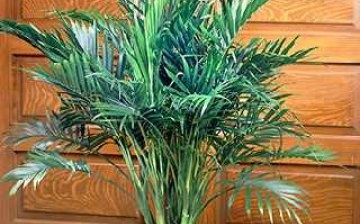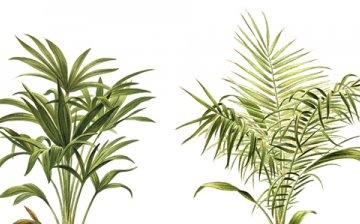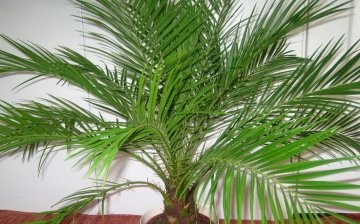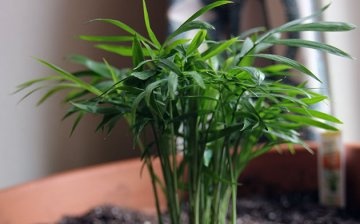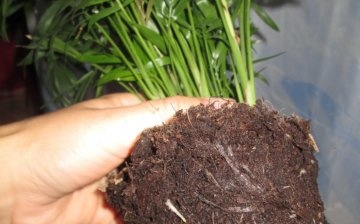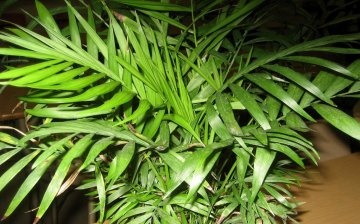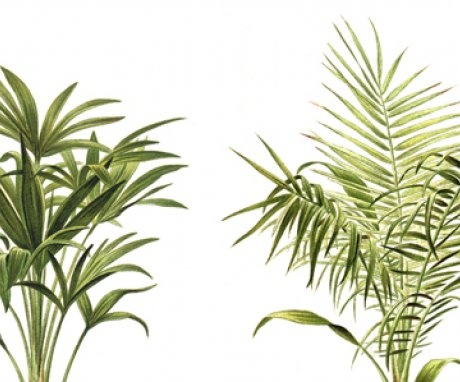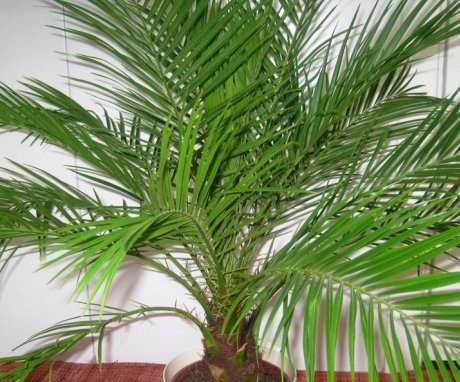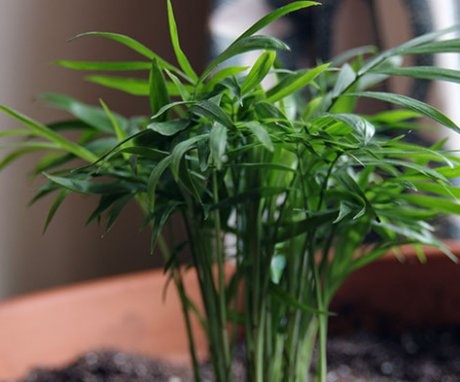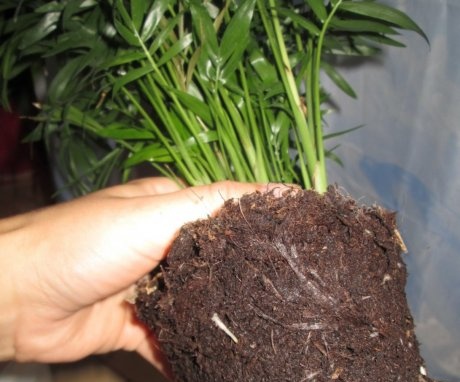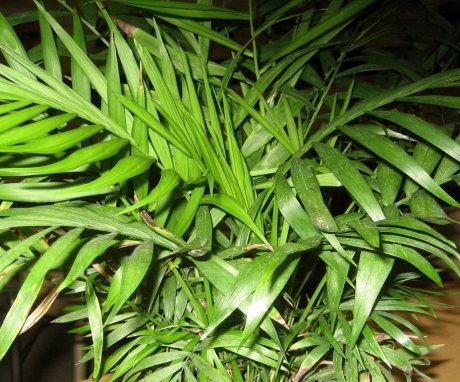Palm Hamedorea: types and rules of cultivation
Hamedorea belongs to the flowering palm plants. Its homeland is South and Central America, where it grows in the mountainous areas of the rainforest. The palm tree has about 130 species, falling in love with flower growers for its exoticism and grace. In the wild, a palm tree can reach five meters in height, and in indoor conditions it rarely grows above two meters.
Palm trees bloom at different times of the year. Small inflorescences take on the shape of panicles and vary from yellow to red. After the end of flowering, black fruits are formed, resembling berries. Flowering takes a lot of energy from the plant, and if there is no purpose in obtaining seeds, then the inflorescences should be removed. Hamedorea is a very useful plant, it is able to purify and humidify the air in the room, thereby reducing the risk of bronchial diseases.
Content:
- The main types of Hamedorea for breeding at home
- Planting and planting rules
- Reproduction of Hamedorea
- How to transplant a plant correctly
- Disease and pest control
The main types of Hamedorea for breeding at home
The most popular types of palm trees:
- Graceful Hamedorea. This type of palm has a bare trunk, dark green leaves and blooms with light yellow flowers.
- High Hamedorea. It can reach 2 meters in height and is one of the least bushy palms of this species. It blooms with orange flowers.
- Monochrome Hamedorea. This palm is the most popular among florists. Has a light green leaf color and light yellow flowers.
- Arenberg has the widest leaves and a thin trunk. A rare species that is quite difficult to find on sale.
- Ernest Augusta is perhaps one of the fluffiest and voluminous palms of this species. It is also a rare and valuable specimen.
Planting and planting rules
Fortunately, Hamedorea is an unassuming plant, and it shouldn't be difficult to get proper care of it. But still, you need to know some subtleties:
- Priming. A mixture of soil for palm trees, which includes turf, peat and humus, is suitable. It is important to put a sufficient amount of drainage on the bottom of the pot (about 1/4 of the capacity). The soil should be loose so that moisture can penetrate into it easily.
- Lighting and temperature. The palm tree does not like bright light, so ideally you need to put the pot in partial shade. The palm tree will be quite comfortable away from the window under artificial lighting. The plant should not be left in a draft; the main temperature should be between 16 and 27 degrees.
- Watering... It is important to provide the palm tree with the conditions closest to its natural growth, so it is worth humidifying the air by spraying the leaves, and periodically wiping them with a damp towel. An exception should be made in winter, as the leaves can be attacked by the fungus. Despite the palm's love for moisture, it must be remembered that excessive watering will lead to rotting of the plant, therefore, liquid stagnation in the soil should be avoided, it should not be wet on top.In summer, watering should occur two to three times a week, and in winter, once a week is enough.
- Top dressing... It is worth feeding Hamedorea no earlier than six months after planting. From spring to autumn, the plant can be fertilized once every ten days, and less often in winter, while the fertilizing solution is diluted with plenty of water. Special fertilizers that are intended for palm trees are suitable.
- Pruning... The palm tree should form a crown, and also cut off the yellowed leaves. Pruning devices must be disinfected and trimmed areas require a solution treatment fungicide.
- Bloom... Palm inflorescences should be removed, as they take all the strength from the plant, and it stops growing. If reproduction of Hamedorea is planned, then the inflorescences are left, since it is from them that you can subsequently get seeds. But it is important to note that this is a rather painstaking process, since in order to obtain seeds, it is necessary to have a female and a male plant, as well as to ensure their pollination. At home, you can use a regular brush and transfer the pollen from the male palm to the female. If everything is done correctly, then seeds will appear, which, when ripe, will slowly descend down the trunk. When the fruits are fully ripe, they will be quite close to the ground and can be harvested.
Reproduction of Hamedorea
You can propagate a palm tree in 3 ways: using seed, at dividing the bush and by planting the basal processes. Reproduction of the plant is usually carried out in the spring. When buying seeds, it is important to pay attention to the expiration date, every month the germination of the seed decreases. The process is quite long, since seedlings may not appear until six months.
Planting procedure:
- First you need to soak the seeds in water for five days, and after softening, remove the top shell.
- Then you should fill the container for planting with the soil mixture, not forgetting about the drainage and thoroughly moisten.
- The seed should be pressed into the soil, leaving the top on the surface.
- A package should be put on the container, thereby providing the desired climate for seed germination.
Reproduction of a palm tree using division should be carried out in late spring. It is necessary to carefully separate the roots from the ground and rinse under running water. Further, it is already possible to disassemble the bush into separate plants and plant in pots with soil.
Reproduction by shoots occurs when they are separated from the mother plant.
It is important that the roots are formed at the processes. Next, they must be planted in a container with soil.
It is important to understand that not all attempts at reproduction of Hamedorea can be crowned with success, a certain percentage of the seeds may not sprout, but seedling do not take root, because the exposure root system - this is a lot of stress for the palm tree. Moreover, it should be borne in mind that Hamedorea is growing slowly. Therefore, it is worth be patient, and it will definitely be rewarded with a beautiful and healthy plant grown in the right conditions.
How to transplant a plant correctly
Typically, a palm tree requires transplants in the event that the root system has filled the entire planting capacity, and this happens no earlier than once every three to four years. Hamedorea can be transplanted in two ways: transshipment or full transplant.
When transshipment, the palm tree is simply moved into a large-volume container, the roots are not cleared of the earth, and the voids are filled with a new soil mixture. This method is the least traumatic.
With a complete transplant, the roots are thoroughly cleaned of old soil, rotten roots are removed and, if necessary, are divided into several plants.
Then they are transplanted into containers with a new soil mixture. It is important to lay a sufficient amount of drainage from expanded clay or small stones on the bottom of the container.
Disease and pest control
Unfortunately, all plants are susceptible to disease and Hamedorea is no exception. The main causes of diseases:
- pests
- lack of proper plant care, in particular, poor drainage
Pests that palm owners may encounter:
- Fungus. If Hamedorea is affected by fungal diseases, it is necessary to treat the plant with fungicides. Processing should take place every ten days. Fungal diseases include pink rot and spotting.
- Mealybug. It feeds on the sap of the palm tree, which is why it retards its growth, the bark cracks, the ovaries fall off, and sticky secretions appear on the surface. To fight the worm, it is enough to wipe the leaves with soapy water, and also once every 7 days, treat the palm tree with infusion from garlic or tobacco.
- Spider mite. The pest is on the back of the foliage. Because of it, it dries up, spots and cobwebs appear. To combat the tick, insecticidal agents are used.
- The scale insect is an insect pest. In appearance, the scale insects are very similar to drops that spread throughout the leaf. They are brown. Scabbards feed on plant juices, and also eat its shoots. In case of infection, the foliage should be washed with soapy water and treated with an insecticide, while carefully cleaning the leaves from the pest. A decoction of garlic or onion peels is also suitable.
More information can be found in the video:
Possible problems that can be encountered while growing Hamedorea:
- Leaves are covered with spots. This can happen if the palm is sprayed in direct sunlight. In addition, the water should not be too hard.
- Root decay is possible in case of excessive glaze and insufficient drainage. Rotten roots must be removed and only healthy ones left.
- The tips of the foliage turn brown when there is insufficient air humidity. Hamedorea should not be placed near radiators and heating facilities; spraying should be carried out regularly.
- Drying foliage. In a palm tree, the lower leaves usually gradually dry up and fall off, but do not rush and remove them. The faster you cut off such a leaf, the sooner the next one dries.
- Rotting leaves that are near the soil. This can be caused by too humid and cold air.
- Lack of growth. This can also be influenced by too low temperatures, as well as lack of nutrients, especially in spring.
- Plaque on the leaves. If it can be easily washed, then it's all about hard water. For watering and spraying a palm, settled water must be used.
Timely and proper care will prevent the occurrence of diseases and damage to the palm tree pests... And the plant, in turn, will delight with a dense crown and active growth.



